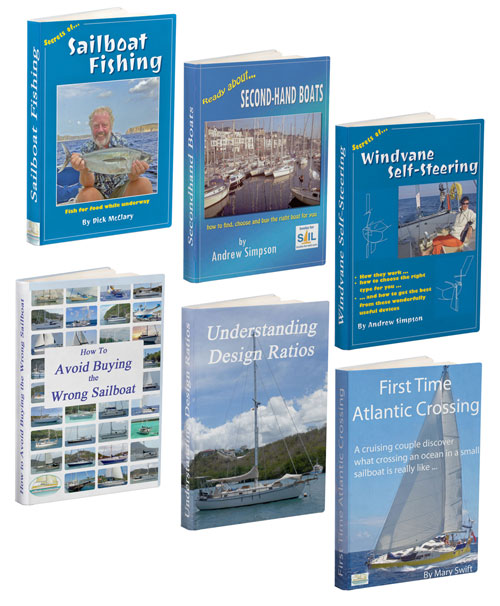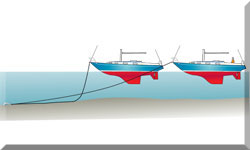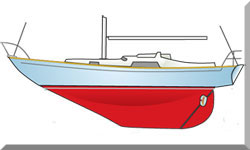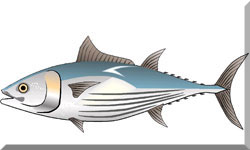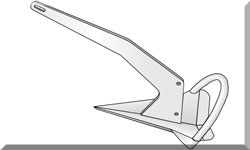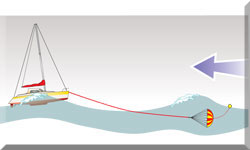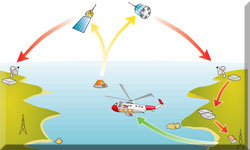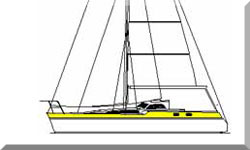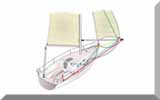- Home
- Offshore Sailing
Offshore Passage Making: A Sailor's Essential Guide
The allure of the open ocean calls to many sailors, promising adventure and self-reliance. However, the sea demands respect. Success offshore hinges on thorough preparation and sound judgment. This Offshore Passage Making Guide provides the essential knowledge for navigating these waters with confidence.
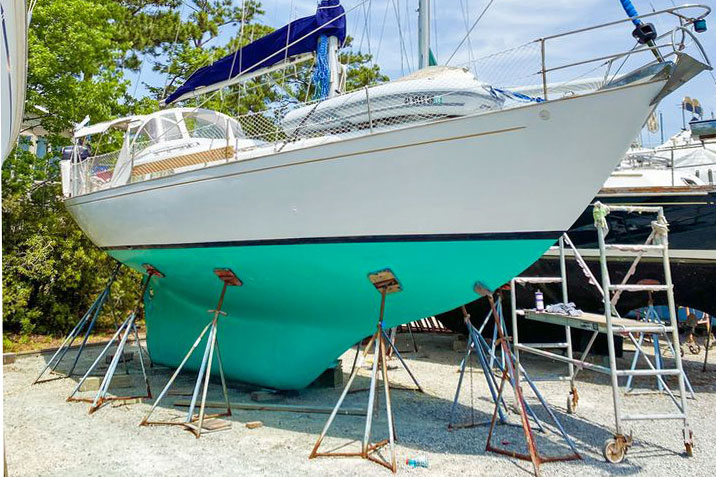 A thorough pre-passage inspection is essential, which you really can't do properly with the boat in the water...
A thorough pre-passage inspection is essential, which you really can't do properly with the boat in the water...Planning & Preparation: Building a Solid Foundation
Before departure, a well-structured plan is crucial. Careful preparation lays the groundwork for a safe and successful passage.
Drafting Your Passage Plan: The Blueprint for Success
Every successful offshore passage begins with a well-crafted plan. This isn't just about drawing a line on a chart; it's a comprehensive document detailing every aspect of your voyage.
A thorough passage plan considers factors such as distance, estimated time of arrival, waypoints, potential hazards, and alternative routes. It incorporates weather forecasts, tidal information, and port entry procedures, serving as a vital navigational and safety tool.
For a detailed breakdown of how to create an effective passage plan, including essential elements and practical examples, please refer to our dedicated article: "Crafting Your Offshore Passage Plan: A Step-by-Step Guide."
Vessel Preparation: Ensuring Seaworthiness
Your vessel is your primary support system at sea; a thorough pre-passage inspection is essential, which you really can't do properly with the boat in the water.
Begin by examining the hull and rigging for any signs of wear or damage, paying particular attention to areas of potential stress. Critically, assess your 12V battery bank, the core of your onboard electrical system.
Offshore passages demand a reliable power source for navigation, communication, and essential equipment. Confirm the battery bank is in optimal condition, checking for corrosion, proper electrolyte levels, and secure connections. Equally important are your charging systems. The engine alternator is the primary charging source, but redundancy is prudent. Consider supplemental charging options, such as solar panels or a wind generator, particularly for extended passages.
Beyond the electrical systems, inspect the engine, fuel, water, and backup systems. Verify that all safety equipment, including the EPIRB, life raft, and flares, is readily accessible and functional.
You'll find our "Condition Survey Checklist" will ensure no critical items are overlooked. Comprehensive preparation is vital for ensuring your vessel is capable of withstanding the rigors of an offshore passage.
Crew Preparation: Forging a Capable Team
Offshore sailing is a team effort. Select crew members for their skills and compatibility. Clearly define roles and responsibilities. Regular training and emergency drills, particularly for man overboard and fire scenarios, are crucial.
Develop a watch schedule that ensures adequate rest and minimizes fatigue. Clear communication and a positive attitude are vital for maintaining morale.
Above all, avoid complacency of the sort described in this article "The Skipper of Alacazam Does Something Really Stupid". It's with acute embarassment that I have to confess the Alacazam's skipper was me.
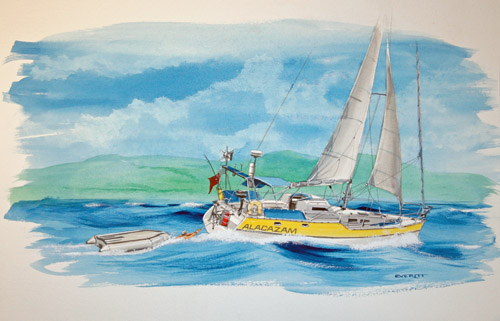 Dick Everitt of Practical Boat Owner magazine illustrated my predicament...
Dick Everitt of Practical Boat Owner magazine illustrated my predicament...Provisioning: Sustaining Life at Sea
Careful provisioning is essential for crew well-being. Plan food and water supplies for the passage duration and potential delays. Explore long-term storage solutions. A well-stocked medical kit and basic first aid knowledge are crucial. Spare parts and tools enable onboard repairs for when things let you down.
The list of spares and equipment required for a long offshore passage will be impressive. Take a look at our article "Sailboat Spares & Equipment for Long Distance Cruising" and you'll see what I mean.
Navigation & Weather: Mastering the Elements
Navigating the ocean requires a blend of traditional and modern techniques. Understanding weather patterns is equally critical.
Navigation Techniques: Finding Your Way
Okay, so you're out there, miles from anywhere. You can't just trust the gadgets, right? GPS and chart plotters are great, sure. They tell you where you are, what's around. But what if they go kaput? Power dies, system crashes, a glitch – you're up a creek. So, you need layers. Like, backups for your backups. Celestial navigation?
That's not just some old-timey thing. Learn it. Get good with a sextant. Know how to find your way with the sun and stars. Dead reckoning? Sounds fancy, but it's just figuring out where you are from where you were. It's basic, but it's crucial. Practice this stuff, even when the electronics are humming along just fine.
AIS and radar? They're like extra eyes. They tell you about other boats, even when you can't see them. But don't just stare at the screen. Look out the window. Keep your head on a swivel. Especially at night, or in busy waters. Know how your gadgets work, too. They're not perfect. They have errors, blind spots. Don't just believe them blindly.
Put it all together. GPS, radar, AIS, the stars – cross-check everything. And don't forget the paper charts. Those big, old-school maps? They give you the big picture. They show you things the gadgets might miss.
And write it all down. Every position, every course change, anything weird you see. It's your track record. You might need it later.
Weather Forecasting: Reading the Signs
Look, out there, the weather's your boss. It doesn't care about your plans. You've got to get good at reading it, not just trusting some app. One forecast? That's a starting point, not the gospel. You need to see what's actually happening.
Learn the winds for where you are, know your clouds, and keep an eye on that barometer. GRIB files? They're like weather maps for sailors. Learn to read them. Wind speed, wave height, pressure – it's all in there.
Weather routing services? They're like having a weather guru on call. They'll tell you what to expect, and how to get there. But don't forget your own eyes. Barometers, anemometers, radar – they're your real-time data.
And then there's the old-school stuff. Wind shifts, cloud shapes, how the sea's acting. A sudden wind change? A falling barometer? Those dark, angry clouds? That's your cue to pay attention.
Remember, those forecasts? They're just guesses, smart guesses, but still guesses. Things change. Fast. So, keep watching, keep thinking, and be ready to change your mind.
NOAA's got some good stuff, by the way. Charts, forecasts, warnings – use them. And write it all down. Wind, clouds, pressure, anything weird. It's like keeping a weather diary. You might need it later.
Safety & Emergency Procedures: Preparing for the Unexpected
Safety is paramount when venturing offshore.
Man Overboard (MOB): Swift Action is Key
Okay, this is it. Someone's gone over. And trust me, you don't have time to think.
Shout it. "Man overboard!" over and over, until everyone hears. Someone's eyes on them, right now.
Don't lose sight. Throw a ring, a cushion, anything that floats. Mark the spot. Hit that MOB button on the GPS, too, if you've got one.
Now, you’ve got to get back there. Quick. You know those turns you practiced? Quick-stop, Williamson, Anderson? Pick one, and do it. Don't second-guess yourself.
Get the rescue gear ready. Sling, harness, ladder – whatever you've got. Everyone's got a job. Someone steers, someone handles lines, someone gets ready to pull them in.
If you can, throw a line, a sling, something they can grab. Keep talking to them, even if they're freaking out. If they're out cold, just get them back on board. Fast. Then, first aid. Get them warm, check them over.
Write it all down in the log. Time, place, how you got them back, anything they hurt. And practice this stuff. Like, a lot. Day, night, doesn't matter. You've got to be ready for anything. Because out there, a few seconds can make all the difference.
Heavy Weather Sailing: Riding Out the Storm
Okay, you weren't expecting this on a tradewind passage, but now the wind's screaming, and the waves? They're like angry mountains. Heavy weather. It's not a joke. You need to be ready for this. Like, really ready.
First thing? Get the boat sorted. Everything tied down, rigging double-checked, storm sails ready to go. You’ve got to know how your boat handles this stuff, too. Don't wait for the storm to figure it out.
Practice when it's just a bit rough. When the big stuff hits, you're not just fighting the wind; you're fighting the sea itself. Heaving-to? It's like finding a sweet spot where the boat just hangs in there, not going anywhere much.
Sea anchor? That'll keep your nose pointed into the waves, which is key. And running before it? That's like surfing, but with a boat. You've got to steer like a pro, though. And talk to your crew. Everyone needs to know what's happening, what you're doing.
Keep an eye on the weather, too. It changes quick. Now's the time to have the parachute sea anchor or the drogue ready to deploy if the conditions become extreme.
Honestly, it's a grind. You're going to be tired. But keep your head, keep your crew safe, and keep the boat in one piece. And write it all down. Wind, waves, what you did, anything that broke. It's not just for the logbook; it's for you. You'll learn from it.
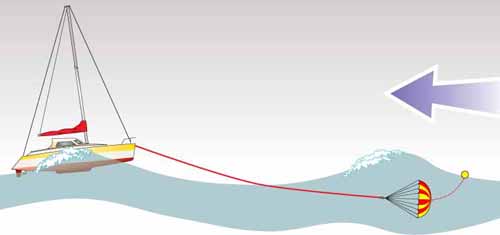 A parachute sea anchor is always deployed from the bow...
A parachute sea anchor is always deployed from the bow...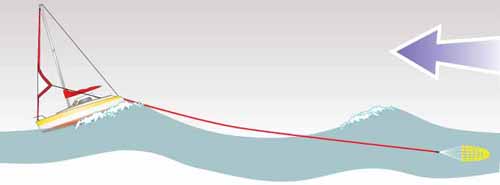 ...whereas a drogue is always deployed from the stern
...whereas a drogue is always deployed from the sternEmergency Communication: Reaching Out for Help
Look, out on the water, you're a long way from help. So, if things go south, you've got to be able to shout. And I mean really shout. First thing's first: know your radios.
VHF? Great for chatting with boats nearby, or the coast guard if you're close enough. But it's line-of-sight, so don't count on it for long hauls.
SSB? That'll get you further, but it's fiddly. You’ve got to tune it right, and the weather messes with it.
Satellites? That's your best bet for real distance, but yeah, it costs.
Now, "Mayday." That's not just a word. It's the big red button. You only hit that when it's life-or-death stuff.
And those beacons, EPIRBs and PLBs? Know how they work. Test them. You don't want to find out they're dead when you need them.
Have a plan for who talks to who, and what you say. And write down those numbers – coast guard, rescue centers, doctors – somewhere you can find them in a hurry.
When you're stressed, you won't remember anything. Practice talking on the radio, too. You don't want to be mumbling when you need to be clear. And every word you say?
Write it down in the log. Times, frequencies, everything. You never know when you'll need it.
Medical Emergencies: Preparing for the Worst
Out there, if someone gets hurt, or really sick, you're pretty much on your own. That's the stark reality. So, you've got to be ready. Forget your basic band-aids; you need a proper medical kit, the kind that deals with the stuff you actually find at sea. Wounds, burns, broken bones, the usual seasickness, and then the weirder stuff, like infections that seem to pop up out of nowhere. And it's not just about the kit.
Someone on board? They need to know what they're doing. Advanced first aid, CPR, maybe even some remote medical training – it's worth its weight in gold. Get familiar with your onboard gear, too.
Those fancy comms systems? Learn how to use them to talk to a doctor, or get rescue help. Have a plan in your head, at least, for what you'd do if things go sideways.
Who does what? What's the first step? When the real deal hits, you won't have time to figure it out. And remember, it's not just about fixing things after they break. Keep the boat clean, get everyone drinking enough water, make sure they're sleeping. You know, the boring stuff. Because honestly, stopping things from happening in the first place? That's the best medicine.
And write it all down. Every little thing. Symptoms, meds, who you talked to on the radio. It's not just for the doctor later, it's for you. You never know when you might need that record.
Onboard Life & Watch Keeping: Maintaining Harmony
A well-organized routine enhances life at sea.
Watch Schedules and Routines: Maintaining Vigilance
Develop a watch schedule that ensures adequate rest. Maintain clear communication between watches and emphasize alertness. Take a look at our article "Watch Keeping for Sailing Yachts on Passage" for proven watch system rotas and how the can be adapted to suit the number of crew aboard.
Maintaining Morale: Keeping Spirits High
Maintain a positive atmosphere onboard. Encourage open communication and address concerns promptly. Find ways to combat boredom and isolation. On a long offshore passage, the arrival of fresh protein in the galley will bring great delight to all crew other than vegetarians. It's easy—there are plenty of fish out there, waiting to be caught— and a simple handline will get the job done.
 a simple handline...
a simple handline...Onboard Maintenance: Keeping Things Running
Out on the water, stuff breaks. It’s just a fact. The salt, the constant rocking, the sheer demand you put on everything – it takes its toll. So, you can’t just ignore the boat. You’ve got to get into a rhythm of checking things.
A daily walk-around? Non-negotiable. Look at fluid levels, sniff for leaks, run your hand along the rigging for chafe, make sure your safety gear's still grab-and-go ready. Little things, right? But they stop the big problems from happening.
And then there’s the longer stuff – winches that need greasing, through-hulls that need a peek, engine servicing. You know, the stuff in the manual, and the stuff you learn as you go. You’re going to have to fix things out there, too. So, get yourself a decent toolkit and some spares for the bits that tend to fail.
Learn to patch a hose, splice a line, get the engine to cough back to life. It’s not just about comfort; it’s about staying safe. And don’t forget to write it all down. Dates, parts, any weird noises or smells – it’s like a medical history for your boat. You’ll thank yourself later, especially if something goes really wrong, and you need to talk to your insurance company.
Logbook Entries: Recording the Journey
The ship's logbook is a vital document that serves as both a navigational record and a chronicle of the voyage. Beyond the formal entries, consider keeping a daily journal or log of less critical but equally important events. This can include a record of crew activities and morale, wildlife sightings, any onboard maintenance performed, the status of meals and provisions, and even personal reflections.
Recently reading the log of our first Atlantic crossing Mary and I did back in 2001, I was reminded of the arrival of a Brown Booby (that's a bird, in case you're wondering) which entertained us daily with his flying displays. You can read his story—or maybe her story—at "A Brown Booby Comes Aboard".
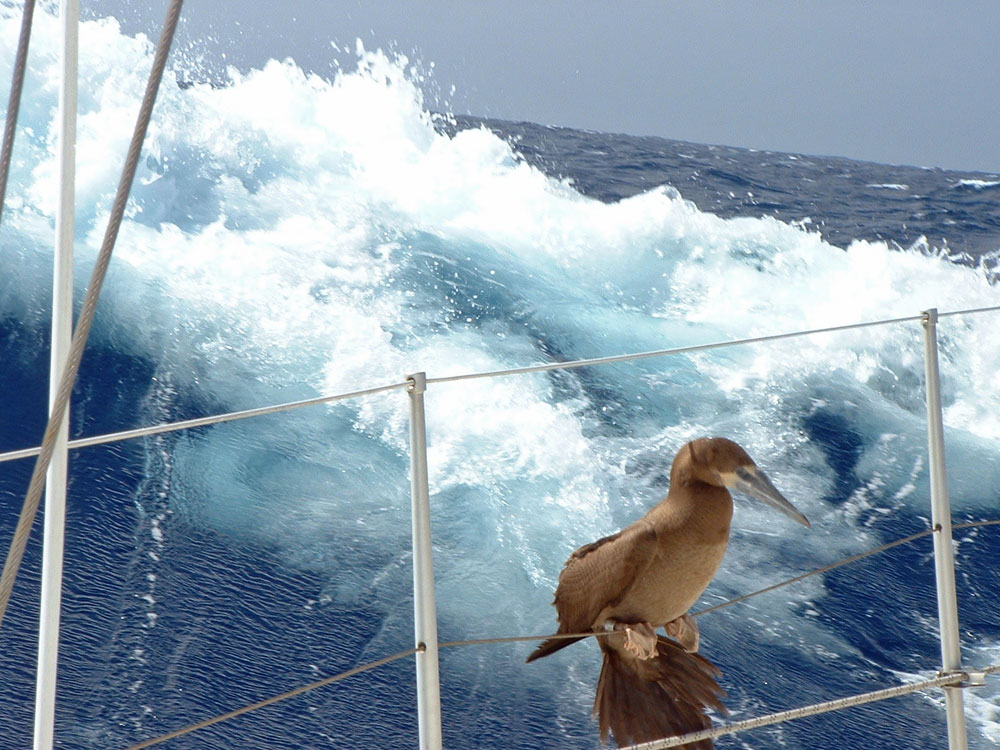 Hang on tight, those web feet weren't designed for this
Hang on tight, those web feet weren't designed for thisArrival & Post-Passage Procedures: Completing the Journey
But it's not over yet—the journey continues upon arrival.
Entering Port: Navigating New Waters
Research procedures for entering unfamiliar ports. Check local regulations and customs requirements. For a typical example of the process, take a look at our article "Yacht Clearance Procedures for the Eastern Caribbean".
Don't forget to fly the appropriate courtesy ensign once you've completed the entry formalities. And talking of flags, now you're sailing in foreign waters it may well be time to brush op on your flag etiquette.
Post-Passage Debriefing: Learning from Experience
Here's the thing about offshore sailing: it's not just checking boxes on a skill list. Sure, you've got to know your stuff – planning routes, keeping your boat shipshape, building a solid crew, reading the weather, handling emergencies.
But honestly? It's way deeper than that. You're heading out into a world that doesn't play by our rules, a place where you learn to bend, adapt, and find your own rhythm alongside the ocean's. And you know what? That's where the real magic happens.
You see bonds form between crewmates that you just don't get on land. You discover a kind of self-reliance you didn't know you had. And the memories? They stick with you, long after you've tied up at the dock.
So, yes, do your homework. Learn the ropes. But don't forget to leave a little room for the unexpected. Because out there, that's where the best stories are written. And that's where you find out what you're really made of.
The ocean's a wild, beautiful, and humbling teacher. Go out there and let it show you what it's got.
.........................
I wrote this article using GPT-4, OpenAI’s large-scale language-generation model, as a research assistant to gather information, summarize research findings, and provide suggestions for the content and structure of the article.
Dick McClary, creator and owner of sailboat-cruising.com
.........................
Recent Articles
-
Multihull Autopilot Selection is Not Straightforward
Apr 19, 25 01:25 PM
Whether its for a catamaran or a trimaran, tiller or wheel steered, a multi hull autopilot must be endowed with specific performance characteristics... -
Wheel-Steering Autopilots: Your Questions Answered...
Apr 18, 25 03:45 PM
Whatever your question, you should find the answer here -
Tiller Pilots: Your Questions Answered...
Apr 18, 25 08:18 AM
Got a question about sailboat tiller pilots? Odds are, you'll find the answer here
